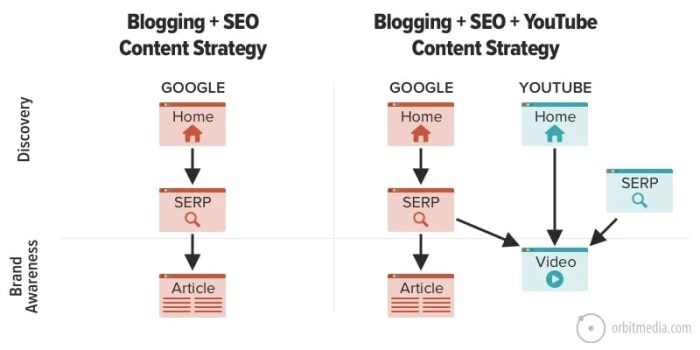
Subscription-based video content strategy is revolutionizing the way audiences consume media, shifting from traditional ad-supported models to a more personalized experience. This approach allows creators to cultivate a dedicated viewer base while fostering deeper engagement through exclusive content. With the rise of platforms like Netflix and Hulu, understanding the underlying principles of subscription models becomes crucial for content creators and marketers alike.
This strategy not only involves crafting compelling content but also necessitates a robust marketing plan and search engine optimization techniques to maximize visibility and attract subscribers. By exploring these aspects, businesses can harness the full potential of subscription-based video services, ultimately driving growth and success in a competitive landscape.
Subscription-Based Video Content Strategy
The subscription-based video content model is designed to provide users with uninterrupted access to a variety of video content for a recurring fee. This strategy has gained traction due to its ability to offer tailored experiences that resonate more with audiences compared to traditional video models. As content consumption continues to evolve, understanding the core principles of this model is crucial for creators and marketers alike.The primary principles of a subscription-based video model include user-centric content delivery, predictable revenue streams, and enhanced viewer engagement.
Unlike traditional ad-supported models, which rely heavily on advertising revenue and viewer numbers, subscription services prioritize content quality and user retention. This approach emphasizes creating a loyal subscriber base by offering exclusive content, personalized recommendations, and an ad-free viewing experience.
Differences from Traditional Ad-Supported Video Content
The contrast between subscription-based models and traditional ad-supported video content is stark, particularly in terms of user experience and revenue generation. Subscription models eliminate interruptions from advertisements, providing a seamless viewing experience. This shift not only caters to consumer preferences for fewer distractions but also encourages deeper engagement with the content. In traditional models, the revenue is largely dependent on viewer numbers and ad placements.
Advertisers pay content providers based on the number of viewers who see the ads, which can lead to a race for higher ratings and clickbait content. Conversely, subscription-based services focus on subscriber growth and retention, with revenue being generated from monthly or annual fees rather than advertising. The following points highlight the crucial differences between these two models:
- User Experience: Subscription services offer ad-free content, enhancing viewer satisfaction and retention.
- Revenue Model: Revenue comes from subscriptions rather than ad placements, promoting content that appeals to subscribers rather than advertisers.
- Content Strategy: Subscription services often provide exclusive and original content to attract and retain subscribers, unlike traditional models which may prioritize mainstream hits for ad revenue.
- Consumer Commitment: Subscribers tend to exhibit a stronger commitment to services they pay for, leading to long-term loyalty.
Key Metrics for Measuring Success
Measuring the success of a subscription-based video service requires a distinct set of metrics that reflect both subscriber engagement and financial health. Understanding these metrics is vital for optimizing content strategy and ensuring sustainable growth. The following key performance indicators (KPIs) are essential in evaluating the success of a subscription service:
- Subscriber Growth Rate: This metric measures the rate at which new subscribers join the service, providing insights into the effectiveness of marketing strategies.
- Churn Rate: The percentage of subscribers who cancel their subscriptions within a given timeframe indicates customer satisfaction and content value.
- Average Revenue Per User (ARPU): This figure represents the average revenue generated from each subscriber, guiding pricing strategies and content investment.
- Engagement Metrics: Metrics such as average watch time and content interaction rates help gauge how effectively subscribers are engaging with the service’s offerings.
The success of a subscription-based video service hinges on balancing subscriber acquisition with retention efforts, ensuring that the content continually meets viewer expectations.
With a clear understanding of these metrics, content creators can better tailor their offerings to meet subscriber needs and ensure the long-term viability of their services.
Video Marketing Techniques for Subscription Services
In today’s digital landscape, video marketing has emerged as a pivotal strategy for subscription-based content services. Harnessing the power of video not only enhances engagement but also drives conversions and retention among subscribers. Crafting a well-thought-out video marketing plan is essential to successfully promote your subscription offerings.A comprehensive video marketing plan tailored for subscription-based content should encompass various elements, including content creation, distribution channels, and audience targeting.
The primary goal is to deliver value through compelling video content that resonates with potential subscribers. Here are key components to consider:
Elements of a Video Marketing Plan
An effective video marketing plan requires a mix of creativity and strategic execution. Below are important elements to include:
- Target Audience Identification: Understand the demographics, interests, and preferences of your ideal subscribers. This information guides content creation and messaging.
- Content Strategy: Develop a diverse range of video types such as trailers, behind-the-scenes footage, testimonials, and tutorials. Content should cater to both potential subscribers and current members.
- Distribution Channels: Identify the platforms where your target audience spends their time. Consider using social media, email marketing, and your own website to distribute video content effectively.
- Call to Action (CTA): Integrate clear and persuasive CTAs within your videos to encourage viewers to subscribe. This can include limited-time offers or exclusive content previews.
- Analytics and Adjustment: Track the performance of your videos through analytics tools. Metrics such as view count, engagement rate, and conversion rate will help refine your strategy.
“Video content is a powerful tool that can significantly enhance the user experience and drive subscriptions.”
Successful video marketing campaigns in the subscription niche showcase the effectiveness of tailored content strategies. For instance, Netflix often employs teaser trailers that highlight upcoming shows and movies, creating buzz and excitement among viewers. These short, captivating snippets not only inform potential subscribers about new content but also remind existing users of the value they receive from their subscriptions.Another example is MasterClass, which uses high-quality video snippets from its classes to engage its audience.
By showcasing renowned instructors in action, MasterClass effectively demonstrates the value of its offerings, encouraging viewers to subscribe for a comprehensive learning experience.
Role of Social Media in Promoting Subscription Video Services
Social media plays a crucial role in the promotion of subscription video services. By leveraging various platforms, brands can reach a broader audience and engage with potential subscribers effectively. Here’s how social media enhances video marketing for subscription services:
- Increased Reach: Social media platforms allow for the rapid dissemination of video content, reaching thousands of users in a short amount of time.
- Community Engagement: Building a community around your content fosters loyalty. Engaging with subscribers through comments, shares, and direct interactions keeps them invested in your brand.
- Targeted Advertising: Utilize social media advertising tools to target specific demographics and interests, ensuring your video content reaches the right audience.
- Influencer Collaborations: Partnering with influencers can amplify your message. Influencers who align with your brand can promote subscription services to their followers, enhancing credibility and reach.
- Feedback and Insights: Social media provides immediate feedback on your video content. Monitoring comments and interactions can offer insights into what resonates with your audience, allowing for continuous improvement.
Incorporating these video marketing techniques and leveraging social media effectively can significantly boost the visibility and appeal of subscription-based video services. By focusing on engaging content and strategic distribution, brands can enhance their growth and subscriber retention efforts.
Integrating Search Engine Marketing with Video Content

The integration of search engine marketing with video content is essential for maximizing visibility and driving subscriptions. By optimizing video content for search engines and employing paid search strategies, subscription services can effectively reach their target audience. This approach not only enhances discoverability but also ensures that potential subscribers encounter high-quality content that meets their interests.Optimizing subscription video content for search engines involves several key strategies that improve visibility and attract more viewers.
Utilizing relevant s, crafting engaging titles, and writing comprehensive descriptions are fundamental steps to ensure that videos appear in search results. Additionally, transcribing video content can help search engines index the material, making it more accessible to potential viewers.
Methods for Optimizing Subscription Video Content for Search Engines
When optimizing video content for search engines, it’s crucial to implement tactics that enhance both user experience and performance. Here are effective strategies to consider:
- Research: Identify and incorporate relevant s into titles, descriptions, and tags. Use tools like Google Planner to find high-traffic terms related to your content.
- Video Sitemap: Create a video sitemap to provide search engines with detailed information about your videos. This helps search engines index your content more effectively.
- Compelling Thumbnails: Use eye-catching thumbnails that can improve click-through rates. Thumbnails should be relevant to the video content and visually appealing.
- Social Sharing: Encourage viewers to share videos on social media platforms, increasing visibility and driving referral traffic.
Combining tactics with an effective video marketing strategy can significantly enhance the visibility of subscription services. Leveraging both organic and paid strategies will create a more comprehensive approach to increasing subscriptions.
Strategies for Using Paid Search to Drive Subscriptions to Video Content
Paid search marketing can be a powerful tool for driving subscriptions to video content. By utilizing targeted ads, businesses can reach specific demographics and encourage them to explore subscription options. Here are effective methods to implement:
- Targeted Ads: Use platforms like Google Ads to create targeted ad campaigns based on user demographics, interests, and online behavior. Tailor ad copy to highlight unique features of your subscription service.
- Video Ad Formats: Explore various video ad formats, such as in-stream ads and bumper ads, to engage users effectively and promote subscriptions directly.
- A/B Testing: Conduct A/B testing on ad creatives and landing pages to determine which versions drive the highest subscription rates.
- Retargeting Campaigns: Implement retargeting campaigns to reach users who have previously engaged with your video content but have not yet subscribed, reminding them of the benefits.
Paid search techniques, when executed thoughtfully, can amplify the reach of video content and convert viewers into subscribers.
Effective Ways to Combine and Video Marketing to Enhance Visibility
The synergy between and video marketing can lead to increased visibility and subscriber growth. Incorporating both strategies requires a comprehensive understanding of their interplay. The following methods highlight effective combinations:
- Content Distribution: Share videos on multiple platforms, including YouTube, social media, and your own website, ensuring consistent optimization across each channel.
- Engaging CTAs: Embed calls-to-action (CTAs) within video content and descriptions, guiding viewers toward taking action, such as subscribing or visiting a website.
- Analytics Monitoring: Regularly monitor analytics to assess video performance and adjust strategies based on viewer engagement and subscription metrics.
- Collaborative Content: Partner with influencers or content creators to expand reach and increase credibility, tapping into their audience base to drive subscriptions.
By understanding and implementing these strategies, subscription-based video content can effectively utilize search engine marketing to enhance visibility and drive user engagement.
Last Word

In conclusion, a well-structured subscription-based video content strategy is key to thriving in today’s digital media environment. By focusing on core principles, effective marketing techniques, and search engine optimization, content providers can create engaging experiences that resonate with their audience. As the landscape continues to evolve, staying informed and adaptable will be essential for achieving lasting success in the subscription video market.
FAQ Compilation
What are the main benefits of a subscription model?
The main benefits include predictable revenue, a loyal customer base, and the ability to create tailored content for your audience.
How can I measure success in my subscription service?
Key metrics include subscriber growth, churn rate, average revenue per user (ARPU), and customer lifetime value (CLV).
What role does social media play in promoting subscription services?
Social media is vital for building brand awareness, engaging with potential subscribers, and sharing promotional content to drive sign-ups.
How often should I release new content to retain subscribers?
Regular content updates are essential; a common strategy is to release new content weekly or monthly to keep subscribers engaged and subscribed.
Can I use traditional advertising alongside a subscription model?
While the focus is on subscriptions, strategic partnerships and select advertising can enhance revenue without compromising the subscriber experience.





